
Printing note: This design was created to be 8.5″ x 14″ and the design pdf will print best on legal size paper.
Wild Ones Meet the Designer Webinar
Las Cruces Native Garden Design Discussion with Designer David Cristiani
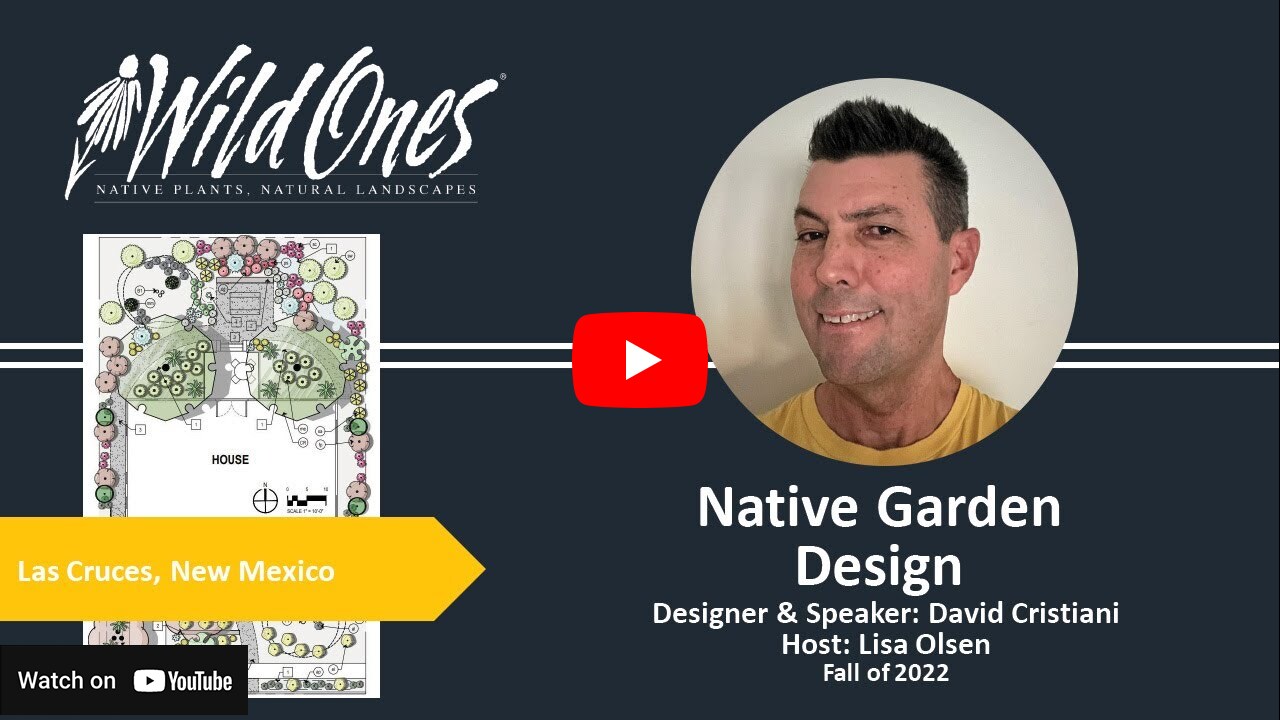
Plant SELECTION
The native plants listed work together in the Las Cruces Native Garden Design. The emphasis is on low water-use, indigenous vegetation occurring in the Chihuahuan Desert Ecoregion and within about 1,000 feet elevation of town. The following provides visual appeal during dormancy or growth times, and more habitat than common landscapes in our area.
Do More with Less
Work with the power of the desert instead of against it. Design the land, outdoor living areas, and plants to require less water and care. Create a local sense of place that supports your style, architecture, property, and the natural ecology – desert soils, plant life, and wildlife.
Design Is Organizing
Solve your property’s challenges by improving function and visual appeal, and provide a place to enjoy it. Everyone can capitalize on expanding their indoor living outward; think in terms of process and pattern. That often includes creating enclosed oasis areas and more open areas, how one wants to use and plant sunny and shady areas, and simple measures to define a bold yet serene place.
Start with water harvesting, called rain gardens in wetter locales. Gentle reworking of grading that still facilitates proper site drainage can also create areas where the occasional rainfall can soak into the roots of plantings, instead of running off and wasting free water. This can make the difference in surviving and thriving, water-efficient desert plants.
Plants forms are mixed; in our sunny and arid climate with a wide range of temperatures over a typical year, rely on forms and foliage for year-round and especially dormant season interest and habitat; greater than half the plantings are evergreen. That provides a backdrop for seasonal flowering to provide its benefits, during the milder times between our brief winters and longer summers.
The front, with steps and a limited area by the front door, includes a waist-high garden wall of mortared rock, to help transition the house and street levels; a subtle but inviting path and small sitting area. In back there are larger sitting or dining areas on the elevated patio, plus a lower gravel area with built-in seating via the lower rock wall behind; plantings are more kinetic, taking advantage of periodic breezy weather yet with a structure of bold or more massed plants. Both sides are narrow, so those are used to access front and back areas or buffer and add visual interest from windows; dwarf trees may add privacy, but greatly restrict access and light.
To provide more visual clarity, similar plants and materials are massed; some open spaces add legibility between plants that is like how arroyos or open spaces function in the desert.
Most of the plants can be bought at local nurseries, though availability varies; searching other nurseries in the region or by mail order can help.
This design and native plant list apply to Las Cruces, neighboring El Paso, and 3,500 to 4,500 feet in elevation along the US-Mexico borderlands. Other regional locations such as Albuquerque, or west Texas may require minor substitutions due to differences in climate and soils.
Begin by Analyzing the Property and Soils
Imagine how you might use your property, including between the home’s inside and outside spaces, good and bad views, and opportunities or limits you’ll need to work with. While that learning period can take months to over a year, one can narrow down that too-large wish list, while being inspired about thriving native and low water-use landscapes locally or even other dry places online. Become familiar with patterns of sun and shade, as that determines where certain areas can be used and at what times.
Soils in the Las Cruces region are mostly Aridisols, desert soils that are alkaline (high pH) and low in organic matter and moisture. Plants in this design are selected for their ability or even preference to grow well in our soils without amendments. This design focuses on plants that perform well on our range of soil types, not only one soil type. Typical soils range from sand with varying amounts of loam or gravel, clay, and in the valley bottom loam with varying degrees of sand or clay. In some areas there are obstructions below the surface limiting drainage and root growth, including caliche or calcium carbonate layers and even rock outcrops near steeper terrain; those must be considered or reworked, if possible.
Desert pavement often occurs in areas where more shrubs than grasses exist, which is much of the Las Cruces area below the mountain edges. It facilitates excessive moisture from remaining at the surface. Gravel mulch in the landscape mimics this desert pavement, conserving moisture for plants.
A private soil testing laboratory can provide a soil test of collected samples for a fee. This will help determine the soil texture and composition, to select plants better suited to your property.
Take Your Time, Do Your Garden Right
Design an overall plan on paper, that considers your uses and the areas required for that to work together. Also, refine that design by simplifying it to only what’s necessary.
Phase 1
Install the infrastructure including fine grading with water harvesting features, basic paving areas with any garden or sitting walls, larger rock including that used for erosion control, irrigation that will allow for future expansion for all future phases, and plants for key areas including all trees and any revegetation seeding. Mulch only at plants. If paving is not in the initial budget, one can install areas of compacted, crushed gravel to serve as temporary paving and walkways or patios. Also, one phase might be to do much of the work in a smaller part of your property such as the back, side, or front, based on your priorities and the area likely to get more use; additional phases might be all or large parts of each remaining landscape area.
Phase 2
Install any garden or sitting walls not installed in the first phase including any boulders, install any water features, install main plantings including larger masses or hedges that tie the overall garden together, mulch materials for all planting areas, ornamental seeding, and irrigation serving those plantings.
Additional Phases
Install any intensive hardscape and paving that can be afforded now. Follow that with installing groundcover and wildflower plantings, container plantings, and irrigation serving those plantings.
A Logical Installation Order Saves Time
Start with site and hardscape work – water harvesting basins to minimize storm runoff and benefit plantings, located away from structures and existing tree root zones, plus walls, walkways, any boulders, and even crushed gravel paths or sitting areas. Water features can be installed now.
Irrigation is next, which helps establish plants but also maximizes tree growth or more dense plantings; drip and subsurface irrigation is best. This design is intended to grow and even thrive with little irrigation, once established. Some plants where served by water harvesting may not require supplemental irrigation after establishment, except during drought. Know and embrace the latter plants.
Planting is best timed when temperatures are consistently below 90F highs and 65F lows. September through April offers the best conditions to install plants, except when windy. The exception would be heat requiring plants including cacti; those establish best March through October.
Other landscape work except mulches can be installed at most any time of the year, even when some plants aren’t able to be installed. This includes fine grading, walls, paving, irrigation valves and main piping, and even compacted gravel areas such as permeable driveways, paths, or informal patios.
Mulches are last and help plants conserve water, decreasing erosion and weed growth. Types should replicate the type found in natural areas for local plant communities. Inorganic mulches (gravel, rock, fines, screening, other aggregates) emulate desert pavement cover in many wild areas and work best for most desert plants, which often have small or succulent leaves; only a 2 inch depth is necessary except larger rock used to minimize erosion. Organic mulches (shredded wood, pecan shells, leaves and twigs) work best for woodland and other leafier plants that require more moisture and are uncommon in open desert; a 3-4 inch depth is typical, but an additional inch should be added each year, as the older organic mulch decomposes into the soil.
Avoid weed fabric or weed barriers for either mulch type; those rarely work but cost extra money best spent on plants and other landscape features.
Site furniture and container plants are a great finishing touch, but those can also go in by area or phase.
Care About Your Irrigation
Adjust timing as plants establish, and seasonally. Clean any filters. Verify drip emitters are functioning and moistening soil at and below root zones, not clogged or causing soil to stay too moist. Clean out or replace emitters, as needed. Check for leaks, and repair if needed.
Make sure irrigation becomes deep and infrequent upon plant establishment; too much water acts as an herbicide to many low water-use plants. Some plants on this design, especially when served with water harvesting, may not require irrigation after establishment, so those emitters can be capped.
Care About Your Pruning, but Don’t Overdo It
Maintenance of plants is important, as it can quickly make or break the success of your garden for people and wildlife. The key is to prune or cut back only for reasons of optimal plant health and growth; that’s a balance of neglect and extra work that’s counterproductive to why one even has a garden. Garden maintenance is about ideal culture, not harsh control.
Trees – prune structurally for health and to slowly reveal natural forms, mostly removing only crossing and dead branches to no more than 25% of live branching when young (no more than 10% after 5 years old or established and previously pruned correctly).
Never top any tree, shear, or shape shrubs into unnatural forms, or cut back foliage on rosette succulents. That doesn’t solve issues such as a poor design or installation, but it often reduces flowering, shortens life spans, causes extra growth that’s weaker, and increases water use.
Grasses –the common practice is to chop back ornamental grasses once they go dormant for the cool season. The browning foliage left is unappealing – tight mounds of stubble for several months, until spring growth resumes. We can do better by doing little to nothing, extending grasses’ lifespans. Instead, let the drying grasses in dormancy provide shelter for overwintering fauna, while you can enjoy seeing the loose grasses wave in the breezes and here their rustling sounds. Only cut back grasses as needed culturally, perhaps every few years to rejuvenate them, and no higher than within a few inches of the ground.
Low Water-Use Native Plants Do Climate Change Better
Plants native to the Chihuahuan Desert have endured the wide range of climate extremes for centuries; some plants in this design grow across varied elevations and latitudes. That, plus nature-based strategies such as water harvesting, only broadens resilience.
Recent decades of climatology show the Las Cruces region’s extremes of heat have not increased in intensity, but there is a trend in increased frequency and duration of hot weather. There also seems to be greater variability in year-to-year precipitation, though amounts have stayed the same or increased slightly. Meanwhile periodic, arctic cold events still occur with a similar frequency and intensity from the past century of records. So, instead of guessing the plants that might make it in our area, but disregarding continued extremes that risk more freeze damage, the optimal strategy is to emphasize plants already native to our area’s historic extremes.
Provide Habitat for Birds and Pollinators, Including Monarch Butterflies
Hummingbirds are attracted to many native, flowering sages and penstemons who’s showy, trumpet-shaped flowers invite them to enjoy their nectar. While feeders help fill in the times when flowers aren’t growing, there’s nothing like the real thing from their favorite native plants in bloom. Granivorous birds including finches and sparrows find a great food source in native grama and sacaton grasses, plus aster relatives such as chocolate flower. That’s especially true when spent seed stalks are left during the late fall into early spring.
This Las Cruces area design attracts many other pollinators including bees, wasps of varied temperaments, moths, and several butterflies. Queens, skippers, sulfurs, and monarchs are some of the common butterflies one can see except during severe drought or mid-winter. Several native milkweeds can be added to provide further benefits. Other plants including some in this design attract monarchs and other butterflies, such as Blackfoot daisy, mistflowers, wild primroses, globemallows, and asters including desert marigold and damianita.
Additional Resources for the Las Cruces Region
Books
- Hummingbird Plants of the Southwest – Marcy Scott
- Rainwater Harvesting for Drylands and Beyond, volume 1 & volume 2 – Brad Lancaster
Online Resources
- Audubon Native Plants
- Harvesting Rainwater – Brad Lancaster
- Pollinator Partnership ecoregion guide (Chihuahuan Desert)
- Biota of North America Program range maps
- Lady Bird Johnson Wildflower Center
PLANT LIST

Alkali Sacaton(Sporobolus airoides)

Apache Plume(Fallugia paradoxa)
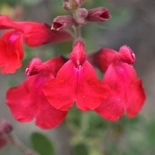
Autumn Sage(Salvia greggii)
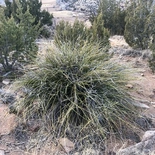
Beargrass(Nolina greenei)
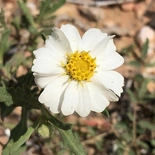
Blackfoot Daisy(Melampodium leucanthum)

Blue Grama(Bouteloua gracilis)
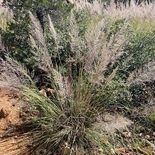
Bull Grass(Muhlenbergia emersleyi)

Chocolate Flower(Berlandiera lyrata)
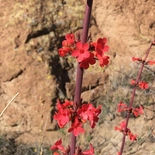
Coral Penstemon(Penstemon superbus)

Desert Four-o-clock(Mirabilis multiflora)

Desert Prickly Pear(Opuntia engelmannii)

Desert Willow(Chilopsis linearis)
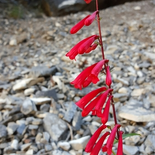
Firecracker Penstemon(Penstemon eatonii)
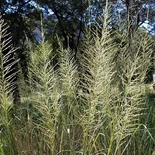
Giant Sacaton(Sporobolus wrightii)
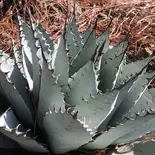
Mescal Agave(Agave neomexicana)

Netleaf Hackberry(Celtis reticulata)

Prairie Sage(Artemisia ludoviciana)

Purple Threeawn(Aristida purpurea)
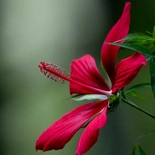
Scarlet Rosemallow(Hibiscus coccineus)
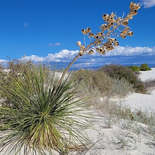
Soaptree(Yucca elata)

Sotol(Dasylirion wheeleri)
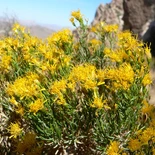
Turpentine Bush(Ericameria laricifolia)
ABOUT THE DESIGNER

David Cristiani is a former landscape architect and planner, and he’s currently a design consultant. His work has an emphasis on planting and hardscape design reflecting the natural sense of place and appropriate to the southwestern United States.
David earned a Bachelor of Science in Environmental Design from the University of Oklahoma, including coursework and ongoing research in geography and meteorology. He’s lived and practiced in the dry, southwestern United States. David’s projects have ranged in scale from small residences to community colleges, healthcare, and streetscapes; much of his career was spent with his solo practice, Quercus. David has contributed writing to publications, presentations, and interviews on appropriate design.
The use of strong, bold forms with simple massing is how he designs, inspired by how plants are spaced and provide habitat, in the powerful but dry western wilds.
About Wild Ones
Wild Ones (a 501(c)(3) nonprofit organization) is a knowledgeable, hands-on, and supportive community focused on native plants and the ecosystem that depends on them. We provide resources and online learning opportunities with respected experts like Wild Ones Honorary Directors Doug Tallamy, Neil Diboll, and Larry Weaner, publishing an award-winning journal, and awarding Lorrie Otto Seeds for Education Program grants to engage youth in caring for native gardens.
Wild Ones depends on membership dues, donations and gifts from individuals like you to carry out our mission of connecting people and native plants for a healthy planet.
Looking for more native gardening inspiration? Take a peek at what our members are growing!
